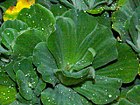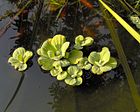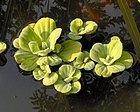Note: This is a project under development. The articles on this wiki are just being initiated and broadly incomplete. You can Help creating new pages.
Pistia stratiotes - Kumbhika
Pistia stratiotes is a small, evergreen perennial plant with feathery roots. Free-floating in lakes, ponds etc. The plant forms rosettes of leaves up to 10cm wide and 6cm tall with a flowering stem up to 12cm tall. The plant can spread quickly, especially in still water, to form quite extensive clumps.
Contents
- 1 Uses
- 2 Parts Used
- 3 Chemical Composition
- 4 Common names
- 5 Properties
- 6 Habit
- 7 Identification
- 8 List of Ayurvedic medicine in which the herb is used
- 9 Where to get the saplings
- 10 Mode of Propagation
- 11 How to plant/cultivate
- 12 Commonly seen growing in areas
- 13 Photo Gallery
- 14 References
- 15 External Links
Uses
Urinary tract infections, Swellings, Dysuria, Stomach problems, Dysentery, Coughs, Asthma, Gonorrhoea, Skin diseases, Boils, Piles.[1]
Parts Used
Chemical Composition
It contains four compounds were obtained and identified as stigmasta-4,22-dien-3-one, stigmasterol, stigmasteryl stearate and palmitic acid.[2]
Common names
| Language | Common name |
|---|---|
| Kannada | ಅಂತರಗಂಗೆ Antaragange, ಕುಂಬಿಕ್ Kumbik |
| Hindi | Jalakumbhi |
| Malayalam | Akasathamara, Kodappayal |
| Tamil | Akasha-t-tamarai, Antara-t-tamarai, |
| Telugu | Antara-tamara, Budaga tamara |
| Marathi | Akashamuli, Jalamandavi |
| Gujarathi | Jalakumbhi, Jalshankhala |
| Punjabi | |
| Kashmiri | |
| Sanskrit | Akashamuli, Jalakumbhika |
| English | Water cabbage, Water lettuce |
Properties
Reference: Dravya - Substance, Rasa - Taste, Guna - Qualities, Veerya - Potency, Vipaka - Post-digesion effect, Karma - Pharmacological activity, Prabhava - Therepeutics.
Dravya
Rasa
Guna
Veerya
Vipaka
Karma
Prabhava
Habit
Identification
Leaf
| Kind | Shape | Feature |
|---|---|---|
Flower
| Type | Size | Color and composition | Stamen | More information |
|---|---|---|---|---|
| Flowering season - December - February | {{{5}}} |
Fruit
| Type | Size | Mass | Appearance | Seeds | More information |
|---|---|---|---|---|---|
Other features
List of Ayurvedic medicine in which the herb is used
Where to get the saplings
Mode of Propagation
How to plant/cultivate
Found though much of the tropics and subtropics at elevations from sea level to more than 1,000 metres. The optimal growth temperature range for the plant is 22 - 30°c. Plants cannot tolerate frosts.[5]
Commonly seen growing in areas
Photo Gallery
References
- ↑ Indian Medicinal Plants by C.P.Khare
- ↑ Chemical constituents
- ↑ Common names
- ↑ [Morphology]
- ↑ Cultivation
External Links
- Ayurvedic Herbs known to be helpful to treat Urinary tract infections
- Ayurvedic Herbs known to be helpful to treat Swellings
- Ayurvedic Herbs known to be helpful to treat Dysuria
- Ayurvedic Herbs known to be helpful to treat Stomach problems
- Ayurvedic Herbs known to be helpful to treat Dysentery
- Ayurvedic Herbs known to be helpful to treat Coughs
- Ayurvedic Herbs known to be helpful to treat Asthma
- Ayurvedic Herbs known to be helpful to treat Gonorrhoea
- Ayurvedic Herbs known to be helpful to treat Skin diseases
- Ayurvedic Herbs known to be helpful to treat Boils
- Ayurvedic Herbs known to be helpful to treat Piles
- Herbs with Leaves used in medicine
- Herbs with common name in Kannada
- Herbs with common name in Hindi
- Herbs with common name in Malayalam
- Herbs with common name in Tamil
- Herbs with common name in Telugu
- Herbs with common name in Marathi
- Herbs with common name in Gujarathi
- Herbs with common name in Sanskrit
- Herbs with common name in English
- Habit - Evergreen perennial
- Index of Plants which can be propagated by Seeds
- Herbs that are commonly seen in the region of Water fields
- Herbs
- Pages without herbs images







